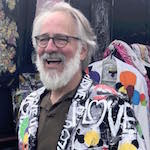First, of course, is the new de Young itself. An impressive modernist structure rising out of the park like part of the earth. Many have objected to the imposing new building, but I have to say it's magnificent. The problem is only in trying to compare it to the old de Young. They are such different museums that is unfair to re-use the same name. The work by Andy Goldsworthy in the courtyard is what turns the imposing structure into part of nature for me.
Okay, on to the exhibition...
"Each section of International Arts and Crafts, which is organized geographically, explores the distinctive characteristics of the Arts and Crafts Movement and the different ways in which its ideas were interpreted as it developed in countries or regions from England to Japan. The movement emerged and flourished in Britain in the 1880s. It then spread to continental Europe and Scandinavia from 1880 to 1914, and to America from 1890 to 1916 before its final manifestation in the Mingei (Folk Crafts) movement in Japan between 1926 and 1945."I found it well organized and learned much about the movement, and its growth as a reaction to the industrial revolution, as we moved from one room (and region/period) to the next. By the time we arrived at the more familiar works of the American period I was practically overcome with emotion at the beauty of the designs - something I would expect to say of an exhibition of "fine art" not "applied art."
Particularly moving to me was a room based on original drawings from Gustav Stickley. All of his furniture arranged in a mock Craftsman living room brought me back to my grandparents house in Cape Cod where I first learned to love these designs and associate them with the warm feeling of home.
Also on display nearby were stained glass doors and other items removed from houses designed by Greene and Greene for the Blacker estate in Pasadena, Tiffany lamps, and other works of the period.
The only part of the exhibition which didn't work for us was the start of the Japanese period room. While the transition between each of the other regions and eras was almost seamless, the jump into the Japanese felt like a move to a different exhibit entirely. Part of this was because rather than simply showing the works, it moved backwards to show some of the other influences on the Japanese designs. While Korean pottery from 1750 is very nice, it feels a bit out of place following the Craftsman architecture.
It did come back together before the end of this section and the exhibit with another mock room, this time showing the blend of the traditional and the modern in a Japanese dining area of the period.
Tags: museums, San Francisco, de Young, arts and crafts, design, architecture, Gustav Stickley, craftsman, Greene and Greene






No comments:
Post a Comment